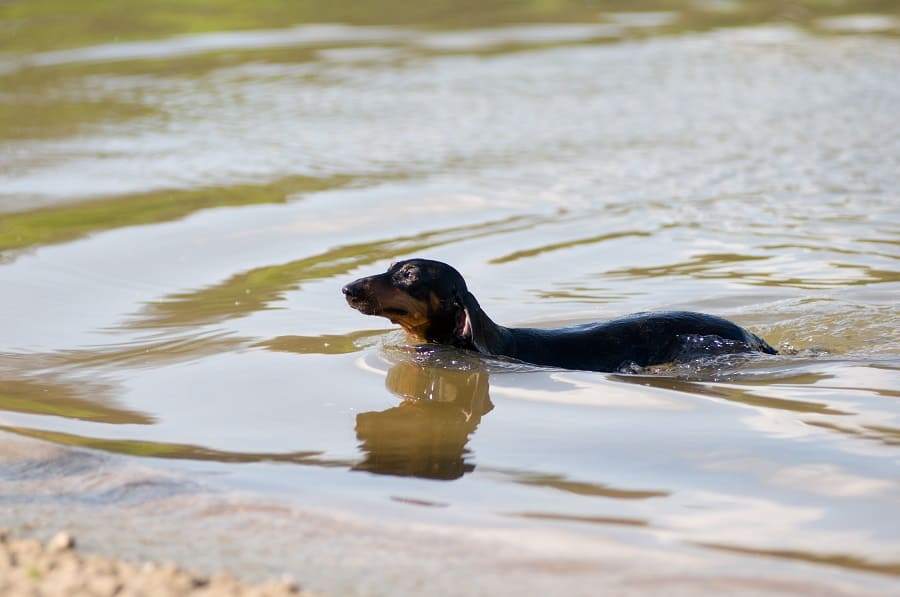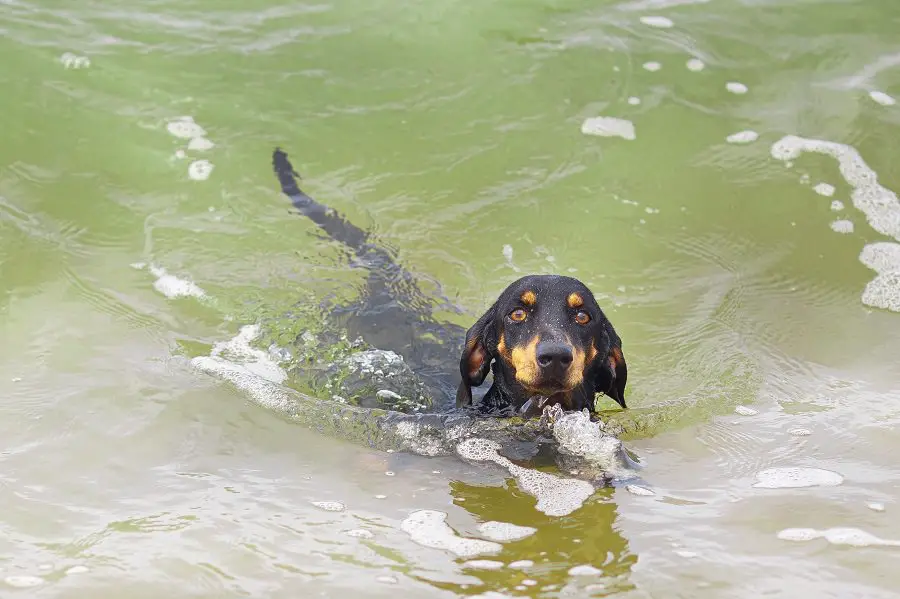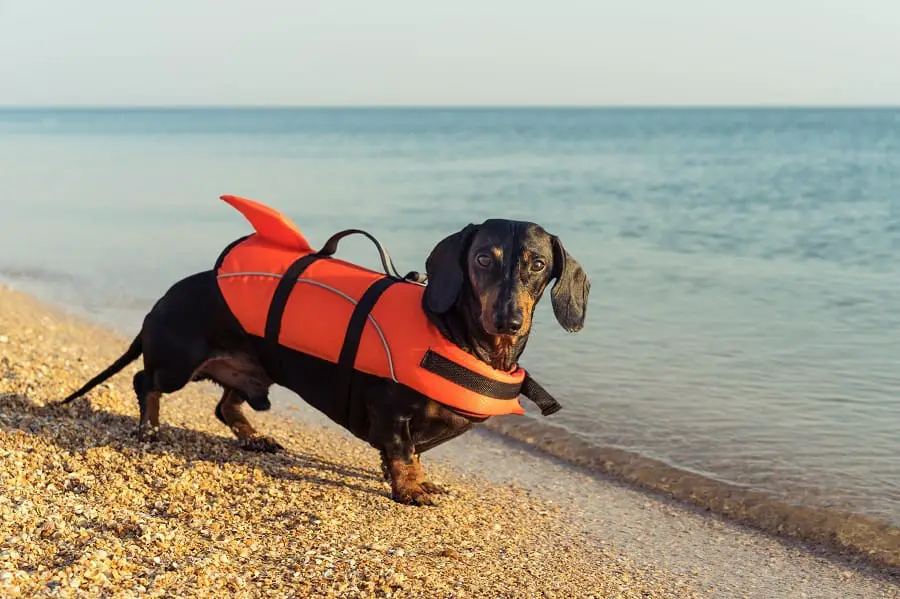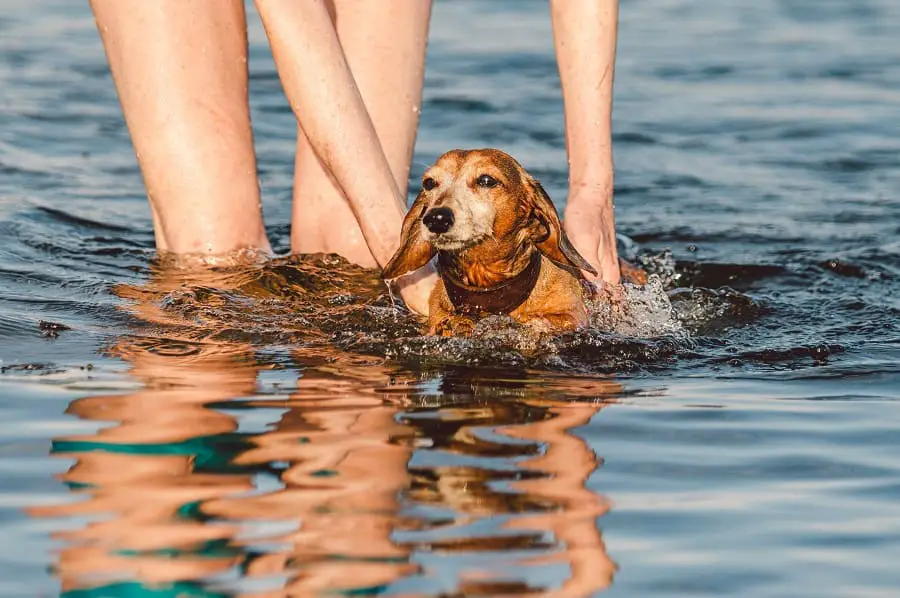H.L. Mencken described dachshunds as, “Half-a-dog high and a dog-and-a-half long.”
What H. L. Mencken didn’t say is that dachshunds were bred that way to dig into tunnels and hunt underground rodents.
Unfortunately, that same body shape is unlikely to make dachshunds Olympic swimming champions.
The bottom line is that these Masters of the Underground Hunt are not designed to stay afloat in water, and they’re more likely to sink than swim.
The good news is that you can teach your dachshund to swim.

It’s a healthy exercise for both of you, it’s an excellent therapy for arthritic joints, and it’s the recommended way to get your dachshund back on his feet after back surgery.
Swimming is also a refreshing alternative to a hot walk on a sweltering summer day.
Take some safety measures and follow a few tips to teach your dachshund how to overcome fear of water, and learn to enjoy a dip in the pool.
If you still feel that you’re on an impossible mission, consider hydra or aquatic therapy and get the professionals to do it for you.
Teaching dachshunds to swim takes patience and time; they’re not natural swimmers.
But once your dachshund knows how to stay afloat, playtime in the swimming pool will become a favorite pastime.
Oceans and lakes vs. swimming pools
The first thing to think about is where you’re going to teach your dachshund to swim.
Ocean

Dachshunds will never be strong swimmers, so the ocean’s strong currents and tumultuous waves are hazardous for them.
The best flotation jackets and strongest leash is no guarantee that you will be able to hold on to them, especially if they get panicked by the thunderous noise of the waves.
Avoid possible tragedy and don’t teach your dachshund to swim in the ocean. Even when your dachshund is a competent swimmer, it may be best to avoid the sea.
Ponds and lakes
Ponds, lakes, and other natural bodies of water are as dangerous for dachshunds as the ocean is, but for different reasons: natural bodies of water are often contaminated with harmful bacteria and pesticides.
These organisms and toxins can cause stomach upsets and skin infections which can be difficult to treat at best, and fatal at worst.
Like the ocean, it’s best not to let your dachshund swim in natural bodies of water.
Even if you have strong objections to the chlorine content in swimming pools, it’s not nearly as harmful as the bacteria and pesticides in natural bodies of water.
Swimming pools

The swimming pool is by far the best option, and the shallow end is ideal for your dachshund’s introduction to water.
You can stay close by to keep your dachshund calm and upbeat, and react quickly should something go wrong.
Safety first
Before you introduce your dachshund to water, there are two safety measures that you should take: one is a ramp for the pool, and the other is a quality dog life jacket.
Ramp
The most common reason that dogs drown is that they can’t get out of the pool: the sides may be too steep or slippery or, in the case of dachshunds, their legs are too short.
Dogs will swim and paddle, unsuccessfully trying to get out of the pool until they’re too exhausted to carry on, and then give up and drown. It doesn’t bear thinking about.
The first safety measure then is to get a dog ramp; you can either buy one or make one yourself.
Some ramps are designed primarily for pools and range in price from reasonable to expensive.
None of them are really cheap so think about making your own; search the internet, especially YouTube, and you’ll see many inexpensive and easy ways to make a dog ramp for the pool.
Life jacket

A life jacket, or flotation vest, is essential, and, in this case, it’s better to choose one based on quality rather than price.
Things to look for when buying a quality dog life jacket are:
-enough flotation to keep your dachshund’s weight afloat
-a solid handle between the shoulder blades so that you can easily lift your dachshund out of the water in an emergency situation
-solid cushioned underbelly support and padded straps that won’t cut into your dachshund’s skin
Also, choose the right size: the life jacket should fit snugly but not too tightly around the shoulders. Your dachshund needs to move his shoulders freely when swimming.
Get your dachshund used to wearing the life jacket before getting into the pool.
If your dachshund has a strong objection to wearing the life jacket, introduce it slowly; put it on for a few minutes the first day, and then gradually increase the time over a period of a week or two.
Also, practice lifting your dachshund up by the handle between the shoulder boulders so that the movement isn’t strange or startling when you do it in the pool.
Like all training, if you’re patient and calm, and willing to bribe with treats, your dachshund will forget to object to the life jacket, and even get to like it.
Introducing Your Dachshund to Water
At last, we’re ready for the fun part; the ramp is in place, and your dachshund is wearing his life jacket like a second skin. It’s time to get into the pool.
Choose a quiet time when you and your dachshund are alone in the pool area.
Get into the shallow end of the pool with one of your dachshund’s favorite toys. Coax your dachshund to follow you into the pool; use treats and praise.
The truth is that this seldom works, but it’s worth a try.
When you’re sure that your dachshund cannot be coaxed into the pool, it’s time to try another method.
Method 1
Hold your dachshund in your arms and get onto the first step in the shallow end. If your dachshund panics, step out of the pool and try a few minutes later.
Keep climbing in and out of the pool until your dachshund is calm and accepts that nothing terrible is going to happen when you step into the pool.
Method 2
Sit on the first step, and slowly lower your dachshund’s paws into the water.
Stop immediately if your dachshund panics; hold your dog in your arms and wait for a few minutes, then try again.
Keep lifting and lowering your dachshund’s paws into the water until your dachshund is used to it. If your dachshund starts paddling, it’s a good sign.
If your dachshund is very fearful and panicked, you may not achieve this in one day.
Be patient and keep trying over a period of days; offer lots of treats and praise. Let your dachshund see you splashing and enjoying yourself in the water. Keep calm and upbeat.
What not to do
The “sink-or-swim” method doesn’t work; don’t throw your dachshund into the pool. Your dachshund will develop a permanent fear of water and will never learn to swim.
Don’t drag or force your dachshund into the pool; a dip in the pool is meant to be fun, not a punishment.
If your dachshund has an open wound, wait for it to heal and close over before starting swimming lessons.
Don’t leave your dachshund in the pool area unsupervised; just like with children, tragedies happen in seconds, but grief lasts a lifetime.
Swimming 101 for Dachshunds
Now that your dachshund has got his feet wet, it’s time to learn the doggie paddle.
The chances are that your dachshund’s paws, or at least the front ones, start paddling when they hit the water.
If they don’t, and to get all four paws paddling, cradle your dachshund’s belly with one hand, lower the legs into the water, and tickle underneath the paws until all four start kicking.
It’s essential that all four paws paddle. Your dachshund will tire very quickly if only the front legs paddle.
When all four paws are paddling, move to deeper water and let your dachshund go.

Stay close by, and if you see that your dachshund is distressed or panicked, cradle your dog’s belly again for support and comfort.
Dogs that love playing in the water, and that may be your dachshund at some future date, sometimes swallow too much water, leading to water intoxication which can be fatal.
If your dachshund starts coughing, or you can see that your dog is taking in a lot of water, take your dog out of the pool and onto dry land immediately.
In any case, instead of spending long stretches in the pool with your dachshund, take some rest breaks on dry ground.
And that’s it. It may take more than one try, and a truckload of treats, but your dachshund will eventually learn to swim and enjoy it.
Show your Dachshund How to Get out of the Pool
The most critical part of Swimming 101 is to show your dachshund how to get out of the pool.
Guide your dachshund to the ramp and teach your dog how to get on it and on to dry land. Use treats if necessary.
As swimming becomes second nature, your dachshund may also start to use the ramp to get into the pool.
Aftercare
Rinse your dachshund off with a hosepipe or a dip in the bath after swimming.
The chlorine and other pool chemicals may irritate the skin if not thoroughly rinsed off with clean water.
Dry your dachshund’s ears thoroughly with a soft towel after swimming.
Dachshunds are prone to ear infections, and water left in their ears for even a short period of time can give them one.
Aqua-aerobics for Dachshunds
If you don’t have the patience to teach your dachshund to swim, or if you have a fear of water yourself, or if your dachshund has had back surgery, you may want to think about dog hydra therapy.
Licensed water therapy professionals use underwater treadmills, balancing boards, and many other techniques to teach dachshunds to swim and get them into tip-top shape.
Hydra therapy is particularly useful for older, arthritic dachshunds. The warm water and low impact exercises ease their pain and stiffness with minimal discomfort.
In conclusion
Dachshunds are not natural swimmers but can be taught to swim and learn to love it. It’s worth the effort because the benefits are enormous.
Swimming is a low impact exercise that doesn’t put a strain on bones and joints, it’s an aerobic exercise that strengthens the heart, it improves general fitness, and it maintains ideal body weight.
We should all do it.
